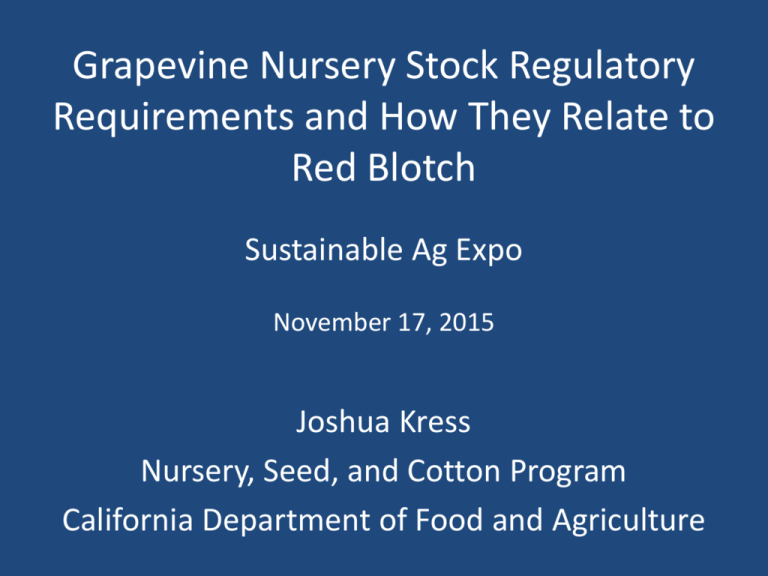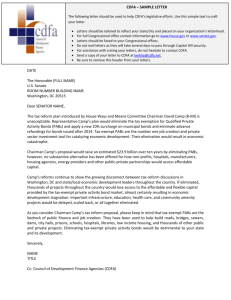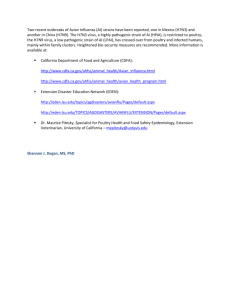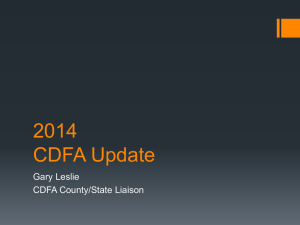Grapevine Nursery Stock Regulatory
advertisement

Grapevine Nursery Stock Regulatory Requirements and How They Relate to Red Blotch Sustainable Ag Expo November 17, 2015 Joshua Kress Nursery, Seed, and Cotton Program California Department of Food and Agriculture CDFA Divisions Animal Health and Food Safety Services Fairs and Expositions Pierce’s Disease Control Program (GWSS) Plant Health and Pest Prevention Services Marketing Services Inspection Services Measurement Standards PHPPS Branches Plant Pest Diagnostics Integrated Pest Control Pest Exclusion Pest Detection / Emergency Projects Pest Exclusion Programs Nursery, Seed, and Cotton Program Exterior Exclusion (Border Stations) Interior Exclusion Emergency Quarantine Response CDFA Nursery, Seed, & Cotton Program • Nursery Services – Nursery licensing – Nursery stock regulatory inspections and enforcement activities – Plant registration and certification services • (7 voluntary programs and 1 mandatory program) • Seed Services – Seed seller authorization – California Seed Law and Federal Seed Act enforcement – Buyer/seller dispute resolution process • San Joaquin Valley Quality Cotton District – Restrictions regarding planting of cottonseed in the San Joaquin Valley Grapevine Import Requirements • Importation of Vitis sp. into the United States is prohibited from all countries, except: – Articles may be imported from Canada under a phytosanitary certificate – Articles may be imported from elsewhere for “experimental, therapeutic, or developmental purposes” under a controlled import permit – In California, Foundation Plant Services (FPS) at UC Davis has a permit from USDA-APHIS to import grapevine material Grapevine Import Requirements • No interstate shipping requirements specific to grapevines coming into California • However, some state and federal quarantines may apply to grapevine plants or cuttings • For more information on bringing plant materials into California, contact the CDFA Pest Exclusion Branch at (916) 654-0312 or peinfo@cdfa.ca.gov https://www.cdfa.ca.gov/plant/pe/transport_animals_plants.html General Nursery Stock Cleanliness Requirements • All nursery stock produced, sold, or held in California must be: – Free from pests not known to be established in California – Free from pests of limited distribution – Commercially clean with respect to established pests of general distribution Inspection of All Nursery Stock • County Agricultural Commissioners inspect nursery stock in California to ensure compliance with cleanliness standards • Inspections of plant material in CDFA’s nursery stock registration and certification programs are performed by CDFA staff History of the Grapevine Registration and Certification Program • 1950: “Virus-free nursery stock program” initiated by CDFA • 1956: Grapevine Registration Program established • 1958: Program amended to include certified stock • 1984: Major changes in testing requirements • 2010: Revised regulations established Grapevine Registration and Certification Program Overview • Voluntary program to certify grapevines for improved confidence of cleanliness for specific diseases of concern • Program includes eligibility, testing, inspection, and maintenance requirements • Top-level source of all program material is Foundation Plant Services (FPS) at UC Davis Grapevine Registration and Certification Program Foundation Plant Services Foundation stock Stock tested at highest level Participant Nurseries Visual inspections and disease testing Increase Blocks (Registered Stock) Participant Nurseries Certified Blocks Visual inspections (Certified Stock) Grapevine Registration and Certification Program Overview • Broad testing for diseases to be entered into the foundation block at FPS • Testing of foundation vines and increase blocks for Fanleaf (GFLV), Tomato Ringspot (ToRSV), and Leafroll (GLRaV) • Visual growing season inspections of foundation blocks and increase blocks, and growing season and harvest inspections of certified plantings • Additional location and source requirements for all registered and certified vines Red Blotch Disease • Described for the first time in Napa Valley in 2008 on Cabernet Sauvignon • Grapevine Red Blotch-associated Virus (GRBaV) first reported in California and New York in 2012 • GRBaV has been detected in the US in CA, NY, VA, MD, PA, TX, and WA, as well as in Canada • Vector(s) not yet known Request for Rulemaking • Summer 2014, CDFA staff met with industry to discuss the program and to hear their concerns • On October 23, 2014, CDFA received a written request to hold public meetings to review and update the regulations and begin the rulemaking process Primary issues and concerns brought up by industry • Red Blotch Disease & the level, timing, and frequency of inspection and testing for all diseases • Block location and eligibility requirements • Traceability of stock in system • Standards for suspending/cancelling certification • Other regulatory and non-regulatory concerns CDFA Response • On December 18, 2014, CDFA held a public scoping meeting in Sacramento to outline these concerns and receive comments on the regulations • CDFA has held 5 additional regional meetings to reach stakeholders in different parts of the state • CDFA has established a working group with subject matter experts and industry representatives to discuss specific issues and suggested changes in more detail • With the public comments and recommendations from the working group, CDFA will develop a rulemaking package(s) to update the regulations Working Group Recommendation For Proposed Rulemaking • At their meeting on September 21, 2015 the Grapevine Regulations Working Group recommended that CDFA pursue rulemaking to add Red Blotch (GRBaV) to: – the list of diseases and disease agents of concern, – the required tests for candidate foundation materials, and – the periodic tests for foundation and increase vines • CDFA is developing a rulemaking package to incorporate this change into regulations • CDFA has begun purchasing equipment and developing sampling and testing protocols to begin testing increase blocks for GRBaV in Fall 2016 CDFA Response • A new e-mail list has been set up for distributing updates on this process, future meetings, etc. • Information presented at these meetings will be posted on our website, along with future meeting notices and other updates http://www.cdfa.ca.gov/plant/pe/ nsc/nursery/grapevine.html Thank you Joshua Kress (916) 654-0435 joshua.kress@cdfa.ca.gov www.cdfa.ca.gov/plant/pe/nsc









